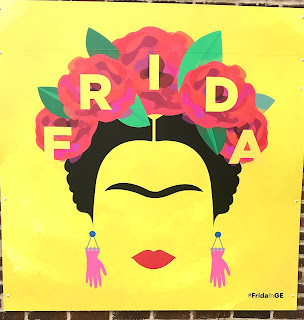 |
I didn't know much about Kahlo other than that she was Mexican and married to Diego Rivera. (I have not seen the biographical movie Frida which came out in 2002.)
Her father was Wilhelm Kahlo, a German immigrant who changed his name to Guillermo. He was a professional photographer. Her mother was mestiza (Spanish/Indian). The family lived outside Mexico City. She aspired to study medicine, but at age 18 she sustained severe injuries in a bus-trolley collision -- spine and pelvic damage that gave her severe pain for the rest of her life. While she was bedridden recovering from surgery she began painting.
Frida married Diego Rivera, already an internationally-famous artist, in 1928. He was 20 years older than she. Their relationship was turbulent -- they divorced and remarried. They both had lovers. But he inspired and encouraged her career as an artist. Their home base was La Casa Azul in Mexico City while they traveled extensively. And all the while she was in pain and had many operations of varying success.
She died in 1954 (Rivera died in 1957). Her greatest fame has come in the decades since her death. This exhibit puts her work into the context of her life, beyond the pop art posters and the unibrow photos.
Actually, there was more ABOUT her than by her.
 |
Her self-portraits often show her injury/disability.
College of DuPage students recreated these dresses based on photographs.






that explains the pained look she seems to have....
ReplyDeleteI've always loved Frida. And if you get a chance, read The Lacuna by Barbara Kingsolver. Frida and Diego are minor characters in the book, but it captured their lifestyle. So glad you got to experience her artwork.
ReplyDeleteI read about her a few years ago and her story was so compelling and sad. One day, I went to Iowa with some coworkers and was excited to go to a restaurant that had her name. My coworker didn't want to go because "we've already had Mexican" and my other coworker said "Del Taco is not Mexican. I don't know what it is, but it isn't that." We ate there because there weren't much choices where we were and we were hungry, and all did like all their food.
ReplyDeleteI don't know much about Freida either so thanks for sharing information from this exhibit. Aren't you fortunate to have a special day with your sister. And happy birthday to you.
ReplyDeleteI have wondered for a long time about the fascination with Frida - your post today has given me a good idea of why that interest exists. Kudos to your sister for a most excellent birthday gift.
ReplyDeleteNow I've got to go research how Kahlo got to be so popular after being largely neglected during her lifetime. Sounds like an interesting exhibit!
ReplyDelete